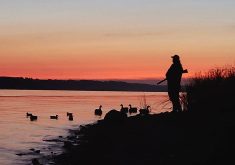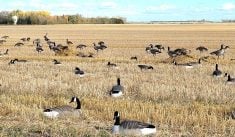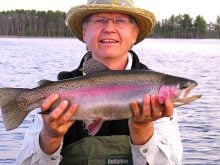My friend Roald wanted to catch a catfish with his fly rod.
I have fly-fished for decades, and the river had been fishing well, so took him out in mid-August. First cast, literally, he struck and landed a 36-inch catfish of about 22 pounds. Over the next three hours he landed eight more, all between 10 and 20 pounds.
I wasn’t completely surprised. After all, we were fishing Manitoba’s GOAT – Greatest Of All Time – fishing spots, the lower Red River.
Read Also

Canada’s ‘Harvest for Victory’ in the Second World War
Propaganda posters celebrating farming show the legacy of Canadian agriculture during the Second World War.
I don’t know of any polls taken to determine the peoples’ choice, but I don’t think I can be swayed on this one. Manitoba’s GOAT fishing spot should have:
- a long history of fishing;
- lots of fish;
- big fish;
- a diversity of fishing experiences and, most importantly,
- be accessible to Manitobans.
Taking all that into account, the stretch of the Red River running from Lockport to Lake Winnipeg wins, hands down.

This stretch starts with the dam at Lockport, built more than a century ago at the bottom end of Lister Rapids, a long and dangerous run that large boats could not traverse. Archaeologists have estimated that Indigenous use of the Lockport site goes back about 8,000 years. Access to a reliable supply of fish seems to have been a key consideration, because fish bones are prominent at all depths of dig sites.
Below Lockport, the river wanders north to Lake Winnipeg, about 30 kilometres away. Low-lying land gives way to the famed Netley-Libau marshes, where the river fans out through one of Manitoba’s largest networks of freshwater coastal wetlands. Fish habitats are productive, diverse and are an important nursery area for Lake Winnipeg fish.
These days the area is fished by folks with $75,000 fishing boats complete with the latest fishing gadgets as well as throngs of people who arrive at the shore with their gear in a pail.
It still has fish in abundance, big fish of many species and year-round opportunities. Day in, day out, most people will catch something, and some will catch big fish that are the stuff of anglers’ dreams.
The biologist in me is always interested in biological diversity. The Red River has 70 fish species, just shy of Manitoba’s top spot, which is the Winnipeg River system with 74 species. I have caught about 15 of them, including a few of the more unusual ones, like stonecats and big-mouth buffalo. I’m not pulling your leg, those are real fish.

Some anglers might shrug at this achievement, but I was tickled when these unusual critters, which I had only seen before in books or museum collections, came to the net.
Then there are the numbers of fish. During the peak summer period in June, I have caught upwards of 50 fish in a morning, mostly freshwater drum, catfish and white bass. One day, just for fun, I estimated the mass of fish caught (all on my flyrod) and it exceeded 200 pounds. I left the water for a late breakfast pretty much exhausted.
In the winter, it’s not unusual to start at dawn and catch 40 or more sauger and a few walleye by 11 a.m. Most are pretty small, but on a cold January morning when I might otherwise be at home reading the paper, it puts a smile on my face.
Catching big fish is always a thrill. By many accounts, the lower Red River is the best place in North America to catch exceptional channel catfish. This one is particularly interesting because, while local anglers had known for decades that big cats were in the river, no one really fished for them. Some were caught accidentally while people were fishing for walleye or other species.

It took American anglers who came in the 1970s to ‘discover’ the catfish, which Indigenous folks had been making use of for millennia. They came from regions where channel cats were king of the hill for anglers, and they were gobsmacked.
One well-known angler wrote about his early rips to Lockport in a how-to book on catfish- ing. With the generous limits at the time – one could keep 10 cats of any size – he noted a group of three anglers could catch and legally keep enough catfish to literally sink a boat.
I don’t think anyone attempted such a stunt, but it got the attention of anglers locally and across the continent, so fisheries managers acted quickly with special conservation measures. People can only keep one large catfish a year, which helps keep populations healthy. Similar rules apply for large walleye. Our provincial managers did the right thing, and they did it in time to save these special opportunities.
The importance of conservation measures has been borne out by research. About a decade ago I caught a tagged catfish and, when I reported the tag number, I learned that a team from the University of Nebraska had been studying this population for years.
My tagged fish was 27 years old. It was a good fish, about 20 pounds, but not at all remarkable by Lockport standards. The research revealed that this is essentially an ‘old growth’ fish population, where larger fish are well over 20 years old and many are over 30. These fish also have very high survival rates after being caught and released by anglers.
Elsewhere, catfish are prized as a food fish. Without the restrictions that Manitoba has in place, the result is very few big fish. My son, Mark, met an angler from Louisiana while fishing from shore one evening. Mark’s new friend said Lockport drew him because, back home, he had never caught a channel cat bigger than five pounds. Mark noted that he had never caught a catfish that small in the Red River! Both of them caught 20 pound plus fish that evening.
Small fish are around, for sure, but it is a truism that it is easier to catch a 20-pounder than it is to catch a five-pound cat at Lockport.
I know that many folks find them ugly and don’t relish the thought of a plateful of fried catfish. For those with what I call ‘walleye myopia’, the lower Red offers up the legendary autumn greenback walleye (pickerel) run.
Walleye in Lake Winnipeg sport a striking emerald green hue overtop the normal black and gold coloration. They also grow relatively quickly in the food-rich waters. These ‘green-backs’ come up the Red from Lake Winnipeg in a last rush to fatten up on minnows before the winter. During the peak of the run, hundreds of boats and countless shore anglers take advantage of the opportunity. Most will catch fish, and many have caught their personal-best walleye during the greenback run, including large number of anglers from other provinces and the U.S.

Saugers, a smaller version of walleye, come up along with the greenbacks and runs carry into the winter. When the ice is secure, ice fishing villages pop up from Lockport all the way down to the mouth of the Red. Permanent shelters, temporary ice fishing tents and pods of folks huddled around ice holes in the open air will number into the thousands on peak weekends. Most will catch fish and some will catch big fish.
In the open water season, I fish this stretch of river as much from shore as I do from the boat. When on shore, chatting with other anglers is part of the fun. I like to see Manitobans taking advantage of our exceptional outdoor opportunities and I am especially gratified to see many folks who are new to Manitoba taking advantage of this fishery.
And why not? It’s a 45-minute drive from downtown Winnipeg. A newbie can go to the local tackle store, put down about $150 for a basic rod, reel, line, tackle and bait, throw it in a pail, walk to the shore and start fishing.
Now, the Red River takes some work before people can expect fish on their lines with regularity, but I’d love to know the number of new Manitobans that have caught their first fish at Lockport. For many, it is their first important encounter with our natural areas.
I am also impressed by the species that are kept, many of which are usually passed up by anglers born into the tradition of eating walleye and little else. Not long ago, I was chatting with a young man from south Asia. He had progressed to fly fishing at Lockport, a fishing style that has taken me years to get good at.
I offered him some of my go-to catfish flies and he wanted to provide some flies in return. Knowing that he usually kept one or two freshwater drum per trip, I told him I’d rather have his recipe for drum! Instead, I got an invite for supper but, alas, COVID came along.
This is a unique and special recreational fishery that has no equal in Manitoba. Our fisheries managers have done an excellent job of managing anglers’ take of fish, so angling opportunities can carry on for a long time to come.
My only hope is that we don’t ever take this special place for granted, and that we give the fish – and the waters that support them – the care and respect they deserve.
















